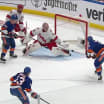"Just pick your spots," Blue Jackets defenseman Seth Jones said. "If I don't like it, I'm getting out of there quick because they're coming. There are many plays in a game where I want to pinch, and I look over and they're coming and I have to back out. That's just a read I have to make. I've been pretty good with that this year. I have to be extra careful in these situations, especially with the firepower they have."
Too often the Blue Jackets have sent three men deep on the forecheck, and without a third man high, the Penguins have been able to pounce on a rebound, a turnover or a loose puck and take off on an odd-man rush. Pittsburgh felt Columbus actually backed off in Game 3, and still it happened.
"Initially, when you're trying to get around the puck and support the puck and try to get possession of the puck, I think that's when you end up with three guys maybe below the goal line, trying to rotate or trying to get possession," Tortorella said. "But eventually I think you've got to make a read as far as, 'Where is the depth? Where is that third guy going to be?' And trust your guys. You don't want to be too far away from the puck, because you still need support.
"There's no set plays you can run on it. It has to be a read by the offensive guys. I think good offensive people, there's good anticipation, and there's cheating. I think there's a fine line of anticipating and cheating, and that's what you've got to walk as far as trying to score goals, but also knowing the team is tramping up the ice going the other way."
Can the Blue Jackets solve it in Game 4? If they can't, can anyone else?


















